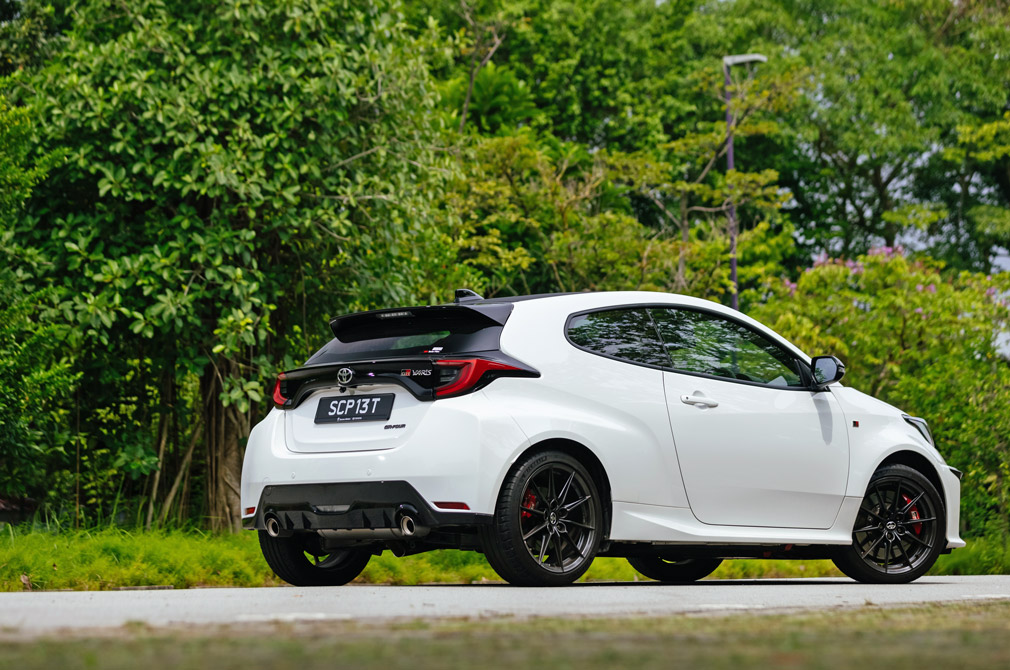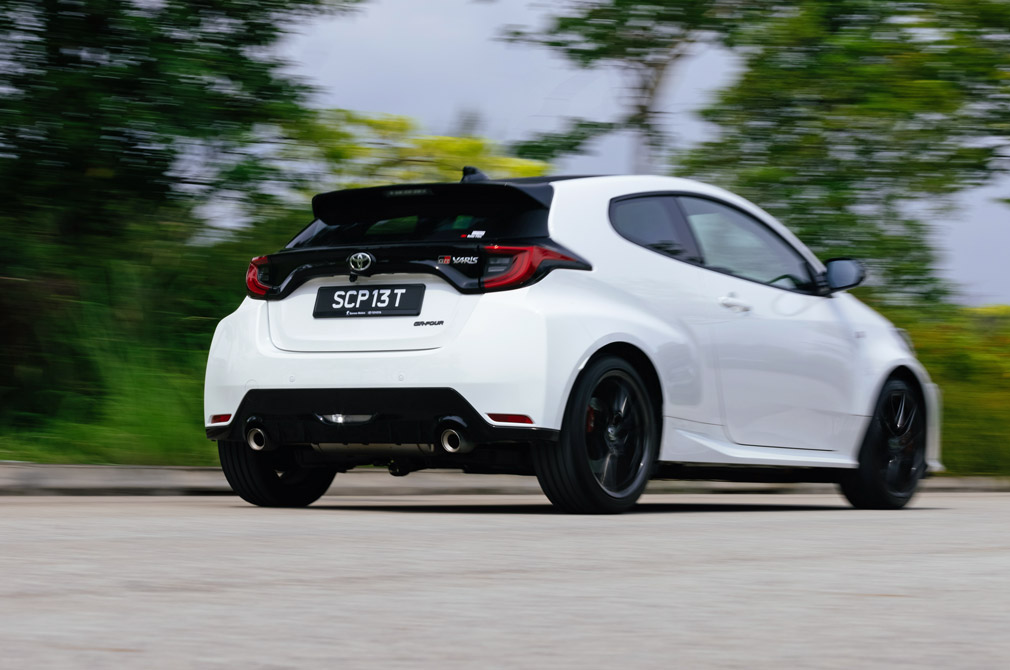
Toyota GR Yaris.
No one with even a passing interest in cars would be unaware of Toyota’s new GR Yaris. It must be one of the most highly-anticipated arrivals in recent memory, with rave online and YouTube reviews long preceding its launch in Singapore. Does it justify the hype, then?
The shopping-trolley Yaris hatchback seems an unlikely base from which to create a world-beating hot hatch. But the changes wrought are so extensive that the GR may as well be a standalone model.

RACY COMPONENTS
For a start it sports a stiffer and lighter 3-door bodyshell instead of the Yaris’ usual 5-door one. Relieved of the need to provide family-friendly headroom for the rear seats, its roofline slopes dramatically downwards towards the truncated tailgate, giving the glasshouse a distinctive, and more importantly aerodynamically-friendly, teardrop shape.
That tailgate, as well as the bonnet and doors, are in weight-saving aluminium, while the roof is carbon fibre-reinforced plastic. Covering the car’s fat tracks are cartoonishly-distended wheelarches – the GR is like a Japanese ChoroQ caricature car model come to life, seemingly almost as wide as it is long.

Visually it sits a little too high above its wheels (in rally-car terms it would be gravel-spec rather than tarmac-spec) but this just drives home the point that the GR is designed for purpose and not posing. It’s hardly pretty, but looks every bit the little thug that it is.
The engine is a puny 1.6-litre 3-cylinder, but is fettled and turbocharged to the muscular tune of 257bhp and 360Nm of torque. Channelling its urge to all 4 wheels via that rarest of things these days – a 6-speed manual gearbox – it hurls the little hatch to 100km/h in just 5.5 seconds, making it possibly the world’s fastest-accelerating 3-pot production car.
There’s been no attempt to dress up the cabin – it is well-assembled but unremittingly functional and plasticky. But no matter, because the ergonomics are good, instrumentation is clearly legible, and visibility is fine.
Of course, the heavily-bolstered front buckets are a clear sign that you’re in no ordinary Yaris, as is the 6-speed gearlever sprouting from the centre console.

FIERY PERFORMANCE
Prod the start button to bring the car to life (this is a manual so you need to dip the clutch while doing so). There is no attention-seeking flare of revs, just a quietly purposeful throb. Again, that sense of purpose over flair.
Into first gear, and the car feels taut and tense as you move off. The ride is firm but well-judged, clearly telegraphing surface imperfections but with enough compliance that they don’t unsettle the car.
Despite the short wheelbase there isn’t any bobbing or pitching, even charging over extreme extreme dips and crests. Road noise at cruising speeds is quite noticeable though – not that the GR’s hardcore target audience will care.
Taken through its rev range the engine pulls terrifically for something so small. It sounds good too, the low-rev throb morphing into an urgent, warbly howl as you approach the 7200rpm limiter.

There is a touch of lag low down – nothing serious – but once into its mid-range groove the car just flings you forward with immense verve. It brings to mind a tightly-wound fist – compact but packing a vicious punch.
All credit to Toyota for sticking with a good ol’ manual gearchange – although the GR’s shift action itself doesn’t stand toe-to-toe with the slick-shifting Type R and MX-5 benchmarks.
It is short of throw but notchy, and the first-to-second change in particular, won’t be rushed. The clutch is springy and has a sharpish biting point, while the throttle pedal is set just a touch too low for easy heel-and-toeing.
SHARP AND PRECISE
Quick as it is, it’s not on the straights but in the bends where the GR brings on the biggest grins, more specifically the tight, tricky bends rather which are its natural habitat.
Point the car into a corner and it just dances in, the short wheelbase giving it insect-like agility while the squat, wide track means that it feels stoutly planted no matter how hard you’re going. Grip at both ends is immense and almost impossible to breach on public roads.
Through all this the steering is sharp and linear, with pleasantly meaty weighting and enough feedback to give you a good idea of the state of the front tyres’ grip, so that you can really lean on the chassis with confidence in its limits.

Being all-wheel-drive, the GR lets you pin the throttle well before corner exit, its Torsen limited-slip diffs front and rear translating all that urge into forward drive with not a horsepower wasted to wheelspin or tyre scrub.
With the drive mode in Sport, the torque split front to rear is 30/70, so given the space, and as YouTube heroes have endlessly proven, it will hold spectacular drifts if you ask it to.
The big, grooved brakes are wonderfully authoritative – with firm pedal feel, good initial bite, and tremendous stopping power. The excellent Michelin Pilot Sport 4S tyres help, as does the fact that the GR weighs under 1.3 tonnes.
So good is the GR, and so towering the reputation that preceded it, that you can’t buy one anymore, not through official channels at least.
Borneo Motors’ allocation of 22 cars is sold out, even at around $200k a pop. But that this wacky, hardcore, maximum-effort car exists – and that its creator is straight-laced Toyota of all people – is reason for all us petrolheads to rejoice. There is hope yet.

=====================================================
UTTERLY COMPELLING
Torque’s resident supercar specialist gives his take on the Toyota GR Yaris.
The Yaris GR is not a “raid-the-parts-bin” project for bigger, better parts. It is a proper made-for-purpose homologation special. And while that might sound like it could be too severe a car for the road, it is not.
It is very straightforward, with no layers to peel off, no need for a selection of comfort/sport/race mode. There is just one mode – perfect. Let me qualify this statement in case a typical Yaris buyer is attracted to this thing.

The GR Yaris is perfect for the true gearhead. It is always in road-warrior mode, but it is surprisingly supple despite the firmly damped suspension. Its engine is “only” 1.6-litres, but this little motor delivers with gusto. And it steers like a 911 GT3.
So, what’s not to like? Well, it has the looks that only a mother would love and a price tag that I guess is for a pukka rally car.
But this thing is simply brilliant to drive. And it is the first car in a long time that made me consider swapping out my Civic FD2R for. – Dr Andre Lam
=====================================================
Toyota GR Yaris
ENGINE 1618cc, 12-valves, inline-3, turbocharged
MAX POWER 257bhp at 6500rpm
MAX TORQUE 360Nm at 3000-4600rpm
GEARBOX 6-speed manual
0-100KM/H 5.5 seconds
TOP SPEED 230km/h
CONSUMPTION 12.2km/L (combined)
PRICE INCL. COE On application
AGENT Borneo Motors
Click here to find out more about the Toyota GR Yaris
We review the Hyundai i30 N here


































